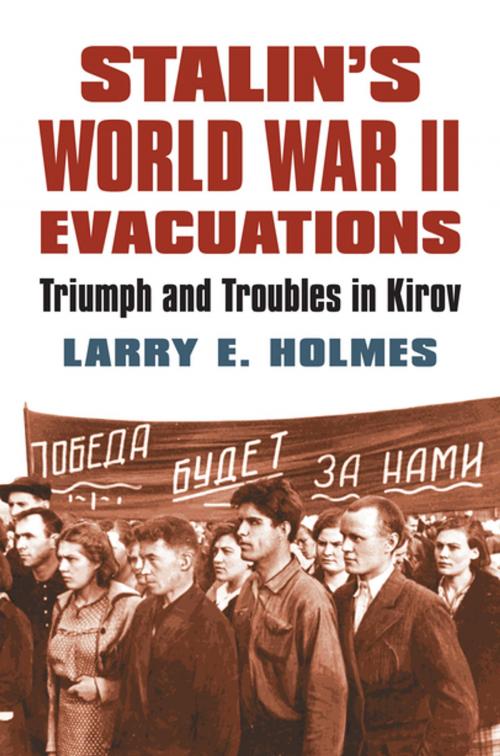Stalin's World War II Evacuations
Triumph and Troubles in Kirov
Nonfiction, History, Military, World War II, Social & Cultural Studies, Political Science| Author: | Larry E. Holmes | ISBN: | 9780700623969 |
| Publisher: | University Press of Kansas | Publication: | February 13, 2017 |
| Imprint: | University Press of Kansas | Language: | English |
| Author: | Larry E. Holmes |
| ISBN: | 9780700623969 |
| Publisher: | University Press of Kansas |
| Publication: | February 13, 2017 |
| Imprint: | University Press of Kansas |
| Language: | English |
In the face of the German onslaught in World War II, the Soviets succeeded, as Molotov later recalled, “in relocating to the rear virtually an entire industrial country.” It was an official declared “one of the greatest feats of the war.” Focusing on the Kirov region, this book offers a different and considerably more nuanced picture of the evacuations than the typical triumphal narrative found in Soviet history. In its depiction of the complexities of the displacement and relocation of populations, Stalin’s World War II Evacuations also has remarkable relevance in our time of mass migrations of refugees from war-torn nations.
The citizens and government of Kirov, some 500 miles northeast of Moscow, provided food, clothing, and shelter to the people and institutions that descended on the region in numbers far exceeding prewar plans or anyone's imagination. But as they continued to share their already strained resources—with adult evacuees, Leningrad’s children, wounded and ill soldiers, factories, and commissariats—the people of Kirov became increasingly resentful, especially as it grew clear that the war would be prolonged, and that their guests demanded privileged treatment. Larry E. Holmes reveals how, without directly challenging the Stalinist system, they vigorously advanced their own private and regional interests. He shows that, as Kirov and Moscow pursued their respective agendas, sometimes in concert but increasingly at cross-purposes, they exposed preexisting and highly dysfunctional dimensions of Soviet governance at both the center and the periphery.
The dictatorial center and the periphery literally came face-to-face in the evacuation to Kirov, allowing for a new, informed understanding of the tensions inherent in the Stalinist system, and of the power politics of the wartime Soviet Union.
In the face of the German onslaught in World War II, the Soviets succeeded, as Molotov later recalled, “in relocating to the rear virtually an entire industrial country.” It was an official declared “one of the greatest feats of the war.” Focusing on the Kirov region, this book offers a different and considerably more nuanced picture of the evacuations than the typical triumphal narrative found in Soviet history. In its depiction of the complexities of the displacement and relocation of populations, Stalin’s World War II Evacuations also has remarkable relevance in our time of mass migrations of refugees from war-torn nations.
The citizens and government of Kirov, some 500 miles northeast of Moscow, provided food, clothing, and shelter to the people and institutions that descended on the region in numbers far exceeding prewar plans or anyone's imagination. But as they continued to share their already strained resources—with adult evacuees, Leningrad’s children, wounded and ill soldiers, factories, and commissariats—the people of Kirov became increasingly resentful, especially as it grew clear that the war would be prolonged, and that their guests demanded privileged treatment. Larry E. Holmes reveals how, without directly challenging the Stalinist system, they vigorously advanced their own private and regional interests. He shows that, as Kirov and Moscow pursued their respective agendas, sometimes in concert but increasingly at cross-purposes, they exposed preexisting and highly dysfunctional dimensions of Soviet governance at both the center and the periphery.
The dictatorial center and the periphery literally came face-to-face in the evacuation to Kirov, allowing for a new, informed understanding of the tensions inherent in the Stalinist system, and of the power politics of the wartime Soviet Union.















